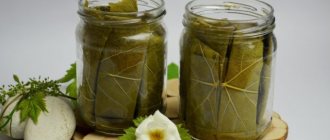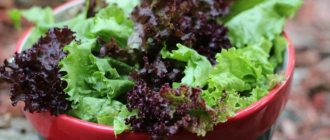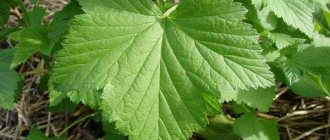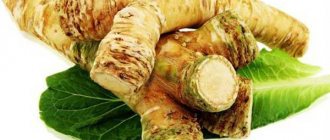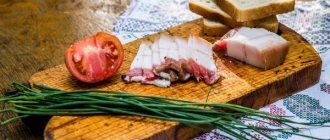Home / Milk / Grape leaves preserved in a jar - how to store them
Dolma is a popular dish in the East. It is similar to cabbage rolls, but the filling is wrapped in grape leaves, which add sourness to the dish. In each country, this dish has its own name, but translated it has the same meaning: “stuffed vegetables or leaves.”
In our country, this food is also gaining popularity, because something new and tasty is always interesting. I first tried it from the local Greeks, now I cook it myself for my family. Moreover, this dish is not only tasty, but also healthy. Any housewife, even the least experienced one, can handle this recipe. You just need to stick to the basic principles and everything will work out well. Today we will talk about how to store grape leaves for dolma.
Canned grape leaves for dolma
Cooking time:
40 minutes.
Servings:
90 leaves.
Calorie content:
93 kcal per 100 g of product.
Kitchen appliances and utensils:
jar, seaming lid and machine, saucepan and hob.
Ingredients
Step by step recipe
- Clear 90 pcs. grape leaves from debris, trim the tails.
Fold in packs of 10 pieces and wrap with a tube. Wrap along, not across, the fibers to avoid breaking.
Tie the tubes with thread and place in a liter jar. Do this with each pack and fill the jar tightly with them.
Fill with cold water, slightly higher than the “hangers” of the jar, add 1 tsp. salt. Cover with a lid for preservation.
Place the jar in a high saucepan and fill it with water just below its shoulders. Cover with a lid, boil and sterilize over low heat for 15 minutes.
Roll up the jar, let cool, cover with a blanket and store in a dark place.
Let's watch a short video that shows in detail how to preserve grape leaves for dolma.
How to Freeze Celery Stems
One option for preparing celery for the winter is to freeze it. This is a fairly simple and convenient way to store this product.
Required Products
:
- Celery stalks – the amount you need;
- ice for cooling water.
Preparation
:
The first step is to separate the stems from each other. This will help thoroughly wash each one without leaving behind any sand or dirt.
Afterwards, the celery stalks should be cleared of hard threads by prying the ends with a knife. Cut to the size you need.
Important! Blanch celery to extend its shelf life when frozen.
While the celery is on the stove, you need to prepare ice water. Add a handful of ice cubes to cold water.
Drain the celery in a colander and immediately place in ice water. This will help you quickly stop the cooking process. Throw the already cooled pieces into a colander again and leave for a while so that all the water drains.
Place paper towels in two layers on a clean table. Place pieces of celery on them so that they do not touch each other. Blot the top with another paper towel. Leave for 30 minutes.
Useful properties and contraindications
Let's talk about the beneficial properties. Since time immemorial, healers have used the natural power of green grapes in the preparation of medicinal potions to cure various ailments. They were used as a means:
- pain reliever;
- antipyretic;
- tonic;
- restorative;
- for women's diseases;
- bleeding;
- upset stomach;
- attacks of rheumatism.
Fox grapes closeup for dolma
Modern science confirms the benefits of grape leaves. They act as an antioxidant, strengthen the immune system and protect the body from aging. Regular consumption of them in the diet:
- enhances vision;
- has a beneficial effect on skin and hair;
- calms the nerves;
- reduces the risk of cancer;
- helps with joint diseases;
- relieves inflammation of mucous membranes;
- helps improve the functioning of the gastrointestinal tract;
- cleanses the body of toxins;
- reduces swelling and venous insufficiency;
- stimulates the work of the heart muscle.
However, grape leaves have a number of contraindications. They are not recommended for use when:
- acute form of gastritis and stomach ulcers;
- obesity;
- tuberculosis;
- diabetes mellitus
Pregnant and lactating women should be especially careful when handling pickled and salted grape leaves, due to the presence of acids and sodium in them.
Grape leaf tea
Having tried this aromatic and tonic tea for the first time, you can become its fan forever. It’s quite easy to prepare “infusion” from grapevine at home. Required:
- Collect young leaves and wash them.
- Fold into an envelope shape.
- Dry in the dryer or oven.
- Grind by hand
- Store in a container in a dry and dark place.
To brew tea you need to take 1 tsp of “grape tea” and pour 250 ml of boiling water over it.
. Leave for 10 minutes and strain. You can brew the drink with the addition of green and black tea.
Drinking pure infusion will help cope with throat diseases; it can also be used to wash wounds or ulcers. You can store the tea leaves until the next harvest.
Dried and crushed grape leaves for brewing tea
This method of saving is the most convenient. You will need:
How to prepare grape leaves for dolma for the winter
Grape leaves have long been popular in oriental cuisine, due to their specific pleasant taste and beneficial properties. It has been proven that the consumption of such an ingredient relieves pain from varicose veins, relieves swelling, stimulates blood circulation, and enriches the body with valuable vitamins and microelements.
It is important that during long-term storage the product retains the maximum amount of useful substances in its composition, therefore, of the existing methods, many housewives prefer freezing.
Interesting: How to determine the suitability of mustard plaster
For these purposes, it is better to choose young specimens of medium size with small veins. It is better to choose the 5th–7th leaf from the top of the vine.
The following foliage is considered unsuitable for cooking:
- from wild (maiden and ornamental) grapes;
- affected by sunburn, mold, fungi and pests;
- with a suspicious yellowish, whitish or cream color;
- old (dangerous due to components harmful to human health);
- growing on a vine near busy roads and industrial production.
Did you know? Dolma has become the source of international controversy: the Azerbaijan National Culinary Center has accused Armenia of “appropriating” the dish, and recently the UNESCO Intergovernmental Committee recognized the traditions of its preparation in Azerbaijan as one of the elements of the intangible cultural heritage of humanity.
Before freezing, it is advisable to prepare the necessary containers. Remember that thin polyethylene and cling film are subject to crumbling under prolonged conditions of low temperatures. In this regard, dense bags are preferred.
Preparing the leaves
To properly freeze grape leaves, you need:
- cut off the ponytails completely;
- thoroughly rinse the workpiece on both sides;
- dry.
Packaging
Dry leaves are stacked on top of each other in 10 pieces and rolled into a roll. In this form, it is packed into bags and sent to the freezer. It is important that there is as little air as possible inside the package. This will protect the product from foreign odors, allow it to cool faster and be better preserved.
Did you know? Dolma was a dish of the court cuisine of the Ottoman Empire.
For proper harvesting, you need to know when to collect and where best to get grape leaves. For dolma, it is preferable to use white grape varieties. Their plate does not have such a jagged edge as the red varieties, and therefore it is easier to wrap minced meat in it. The foliage is collected when the bush is flowering, in late spring or early summer.
Tender leaf blades five through seven are best, if you start counting from the top of the vine. The average size roughly corresponds to the size of the palm: this will be the most convenient way to wrap the filling.
Leaves are cut off before spraying grapes with chemicals. During the summer, you can also carry out pruning, making sure that after treating the plant with fungicides and insecticides, the period specified in the instructions for the drug passes.
Important! Do not eat products from bushes located along highways!
As with any preparation, the quality of the raw materials plays a crucial role, so it is important to understand which leaves can be used for cooking. They should be a uniform green color, without yellowing, spots or signs of pest damage.
There are several ways to prepare food for the winter, the simplest of which is freezing. But the pickled shell has an additional original flavor. Let's consider all possible ways of harvesting grape leaves.
Freezing
Prepared leaves for freezing must be completely dry. Then they do this:
- Place 10–15 leaves and roll them into a tight roll.
- The roll is wrapped in cling film.
- The rolls are placed in a plastic box, since the product will be fragile after freezing.
To prepare dolma, the pieces will need to be defrosted at room temperature or doused with boiling water.
Important! The number of leaves in one roll should correspond to the amount of dolma that is usually prepared at a time.
Bottled storage
This is an original way to keep leaves fresh for a long time. For it you need to prepare empty plastic bottles. The further procedure is as follows:
- Pour a teaspoon of salt and soda into each bottle, add a little water and shake thoroughly so that the mixture covers the entire inner surface. Then the bottle is rinsed with clean water and dried.
- Small stacks of leaves (3–5 pieces) are rolled into tubes and placed very tightly in the bottle, carefully tamping them down with a stick. The bottle must be completely filled. Sometimes a little salt is added at this stage.
- The bottle is pressed down to release all the air and securely closed with a lid.
This container is stored in a dark, cool place for up to 2 years. To prepare, you need to cut the bottle, remove the leaves and fill with cold water. Sometimes a yellowish coating may appear on the surface, which is not a sign of spoilage.
Did you know? In some regions, fig and quince leaves are used to prepare dolma.
Canning
For preservation, it is necessary to properly prepare glass jars and lids. Sterilization of dishes can be done in a pan of boiling water, in a double boiler or slow cooker, in a microwave or oven. Each jar should be treated with hot steam for 20–25 minutes. With this method, the cuttings do not need to be cut; it will be convenient to use them to pull the workpiece out of the jar. Proceed with the prepared leaves as follows:
- The leaves are rolled into a tube and placed tightly in jars, which are then filled with boiling water for 10 minutes. Afterwards, drain the water and fill the jar with boiling water again.
- Add 1 tbsp per liter of water. l. salt and sugar. Bring the mixture to a boil, stirring to dissolve the salt and sugar.
- The water from the cans is drained and filled with a boiling solution.
- The jar is rolled up and gradually cooled.
Interesting: How long can raw meat be stored in the refrigerator?
This product should be stored in a cool and dark place.
Pickling
Containers for pickling are processed in the same way as for canning. Then do this:
- Place 4-5 peppercorns, 1-2 buds of dried cloves, 1-2 bay leaves at the bottom of the jar.
- Rolled leaves are placed tightly on top of the spices and filled with the same solution as for preservation, with the addition of 2 tbsp. l. 9% vinegar.
- The jar is closed and stored in a cool place for up to three months, and dolma can be prepared from such a preparation in just a few days.
Pickling
Salting consists of placing the product in a solution of table salt. To pickle grape leaves, do this:
- The rolled rolls are placed tightly in a clean container and poured with boiling water. After 10 minutes, the water is drained.
- The saline solution is prepared based on the proportion: 20 g of salt per 1 liter of water. Add the required amount of salt to the drained water, bring the solution to a boil and pour it into the jar.
- Cover the container tightly, cool and store in the refrigerator.
Dry storage
For this method, brine filling is not used, but the container must be sterilized beforehand. The sequence of further preparation of the workpiece is as follows:
- Place 10–12 leaves at the bottom of the jar, press down and lightly sprinkle with salt.
- The next layer is compacted tightly and salted again.
- The filled jar is sterilized for 10–15 minutes in the oven or steamed, and then closed with a lid using a special key.
Grape leaves are an integral part of dolma. And although this oriental dish is in many ways reminiscent of cabbage rolls, traditional for Slavic cuisine, they cannot be replaced with white cabbage. In order to enjoy the spicy taste of the dish all year round, you should prepare the future “wrapper” for the rice and meat filling in advance for the winter. Is it possible to freeze it, and how to do it correctly, find out further from the article.
Grape leaves have long been popular in oriental cuisine, due to their specific pleasant taste and beneficial properties. It has been proven that the consumption of such an ingredient relieves pain from varicose veins, relieves swelling, stimulates blood circulation, and enriches the body with valuable vitamins and microelements.
For these purposes, it is better to choose young specimens of medium size with small veins. It is better to choose the 5th–7th leaf from the top of the vine. This wrapper is easy to work with, which is not the case with wrappers that are too small or too large. Leaves should be picked between late spring and mid-June, when they reach their peak growth. Healthy, well-developed specimens of regular shape without damage or signs of disease are preferred.
Oriental dishes have long been part of our lives. For example, dolma, beloved by many. It is very similar to our cabbage rolls. Only for its preparation they use grape leaves instead of cabbage leaves. Fans of this unusual dish for our area may be interested in how to store grape leaves for dolma so that it can be prepared even in winter.
Let's take a closer look at each of them.
The easiest way to store grape leaves for dolma is to sterilize them and roll them into jars.
- In order for them to retain their qualities for a long time, they are collected in 10-15 pieces and rolled into a tight roll.
- Then, the leaves folded in this way are placed in a glass jar and sterilized for 20 - 25 minutes, having previously closed the lid tightly.
- After the jars have cooled, they are rolled up and placed in a dark and dry place.
- The optimal period for collecting grape leaves is the time when the vine begins to flower.
- It is recommended to use leaves of white grape varieties for preservation, since they differ favorably from others in their sweet and sour taste, which will positively affect the taste properties of dolma, giving the dish a wonderful piquancy. If you decide to use red grape leaves for harvesting for the winter, remember that their disadvantage is their uneven surface and hardness.
- Only young leaves are suitable for dolma, and it is important to cut them from the vine, which is located as far as possible from the roadway.
- Never use damaged or torn grape leaves for preservation. Take only smooth, whole leaves, preferably the same size.
- Cooking time: approximately 35-50 minutes.
- Number of blanks: 3 blanks of 20 leaves.
Interesting: What is the best way to store garlic in an apartment?
How long can frozen celery be stored?
Shelf life depends on pre-treatment, cutting method and storage conditions:
- The finer the cut, the faster the product will lose its quality. Celery frozen with whole cuttings will last up to 12 months; grated root vegetables are good for up to 6-7 months.
- Blanched vegetables last longer than unblanched vegetables. For comparison: chopped stems without blanching - 2-3 months, blanched - 10-12 months.
- An optimal temperature of -18ºС will help celery stay fresh throughout the year. In warmer conditions (about -10ºС) the period is reduced significantly.
Try to freeze foods at the same time - adding fresh “brethren” to the freezer increases the temperature and shortens the shelf life.
Lifehacks for freezing celery:
- It is advisable that the freezer has a “No Frost” system, then you don’t have to be afraid that the celery will freeze.
- If you make the freezer bags flat and place them vertically in the chamber, they will be easier to remove.
- Not only the vegetative parts of the vegetable are frozen, but also the juice squeezed out of it, for example, in ice cube trays.
- There is no need to defrost celery before adding it to hot dishes: just add it to simmering broth or stew.
Defrosting features
If you want to prepare dolma, carefully remove the bundle of leaves from the freezer. Try not to press it, as the product is fragile and will crumble at the slightest impact. To prevent the frozen “wrapper” from breaking into small pieces without unwinding, pour boiling water over the leafy roll and allow it to absorb the necessary moisture for a few minutes. The product can then be used for its intended purpose.
You can prepare dolma at any time of the year, thanks to properly prepared raw materials for future use. By following our recommendations, you can easily provide yourself and your loved ones with this opportunity.
- 3-4 hours before cooking, remove the bundle from the leaves and, without unwrapping, smash it on the bottom shelf of the refrigerator.
- Pour boiling water over the leafy roll. Wait a few minutes for the moisture to be absorbed. Now you can use the leaves for their intended purpose.
Celery juice for the winter
Celery juice does not taste very pleasant, but it is an excellent assistant in the treatment of many diseases and the prevention of colds. Therefore, it is still worth stocking up for the winter.
Petiole celery can be frozen
. This limits the possibilities of its further use - thawed stems will no longer be elastic and crispy, so they will have to be used for preparing hot dishes, not in salads.
But, if we are talking about long-term storage, freezing is the best option, since the vegetable can be stored in the refrigerator without freezing for longer than a few days. Drying is impossible without the use of special equipment. Freezing is quite simple, the main thing is to follow the instructions.
